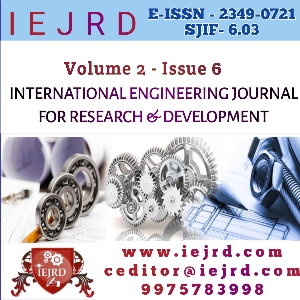AUTOMATION TESTING IN AGILE METHODOLOGY
Keywords:
Automation, Agile Methodology, Software Development, Technologies.Abstract
Automatic testing and automation in the open are essential. Automation in Agile method has gained popularity since its development and continues to be used by software developers worldwide. The widespread use is mainly due to its speed, unequal return on investment, reliability, similarity, and redundancy, allowing developers to develop high-quality software in a short amount of time and with limited functionality. The most widely used aging methods today are XP (Master Plan) and SCRUM. Others include Kanban, the development of trust, and Crystal's methods.
Downloads
References
Collins, E., Dias-Neto, A., & de Lucena Jr, V. F. (2012, July). Strategies for agile software testing automation: An industrial experience. In 2012 IEEE 36th Annual Computer Software and Applications Conference Workshops (pp. 440-445). IEEE.
Collins, E. F., & de Lucena, V. F. (2012, June). Software test automation practices in agile development environment: An industry experience report. In 2012 7th International Workshop on Automation of Software Test (AST) (pp. 57-63). IEEE.
Corbin, J., Strauss, A.: (2015) Basics of Qualitative Research: Techniques and Procedures for Developing Grounded Theory, 4th edn. Sage, London (2015)
Crispin, L., & Gregory, J. (2009). Agile testing: A practical guide for testers and agile teams. Pearson Education.
Dorairaj, S., Noble, J., & Malik, P. (2012, May). Understanding team dynamics in distributed Agile software development. In International Conference on Agile Software Development (pp. 47-61). Springer, Berlin, Heidelberg.
Dustin, E., Rashka, J., & Paul, J. (1999). Automated software testing: introduction, management, and performance. Addison-Wesley Professional.
Gandomani, T. J., & Nafchi, M. Z. (2015). An empirically-developed framework for Agile transition and adoption: A Grounded Theory approach. Journal of Systems and Software, 107, 204-219.
Sikender Mohsienuddin Mohammad, "AN EXPLORATORY STUDY OF DEVOPS AND IT'S FUTURE IN THE UNITED STATES", International Journal of Creative Research Thoughts (IJCRT), ISSN:2320-2882, Volume.4, Issue 4, pp.114-117, November-2016, Available at :http://www.ijcrt.org/papers/IJCRT1133462.pdf or http://doi.one/10.1729/Journal.24201
Gao, J., Tsao, H. S., & Wu, Y. (2003). Testing and quality assurance for component-based software. Artech House.
Glaser, B. G. (1992). Basics of grounded theory analysis: Emergence vs forcing. Sociology press.
Glaser, B. (2010). Grounded Theory Institute: Methodology of Barney G. Glaser.
Gregory, J., & Crispin, L. (2014). More agile testing: learning journeys for the whole team. Addison-Wesley Professional.
Hoda, R., Noble, J., & Marshall, S. (2010, June). Agile undercover: when customers don’t collaborate. In International Conference on Agile Software Development (pp. 73-87). Springer, Berlin, Heidelberg.
Sikender Mohsienuddin Mohammad, "CONTINUOUS INTEGRATION AND AUTOMATION", International Journal of Creative Research Thoughts (IJCRT), ISSN:2320-2882, Volume.4, Issue 3, pp.938-945, July 2016, Available at :http://www.ijcrt.org/papers/IJCRT1133440.pdf or http://doi.one/10.1729/Journal.24061
Manifesto, A. (2001). Principles behind the agile manifesto. Retrieved July, 23, 2005.
Marick, B. (2003). Agile testing directions: tests and examples.
Papadopoulos, G. (2015). Moving from traditional to agile software development methodologies also on large, distributed projects. Procedia-Social and Behavioral Sciences, 175, 455-463.
Taipale, O., & Smolander, K. (2006, September). Improving software testing by observing practice. In Proceedings of the 2006 ACM/IEEE international symposium on Empirical software engineering (pp. 262-271). ACM.
Sikender Mohsienuddin Mohammad, "AUTOMATION TESTING IN INFORMATION TECHNOLOGY", International Journal of Creative Research Thoughts (IJCRT), ISSN:2320-2882, Volume.3, Issue 3, pp.118-125, August 2015, Available at :http://www.ijcrt.org/papers/IJCRT1133463.pdf or http://doi.one/10.1729/Journal.24200
Downloads
Published
How to Cite
Issue
Section
License

This work is licensed under a Creative Commons Attribution-NonCommercial-NoDerivatives 4.0 International License.


















